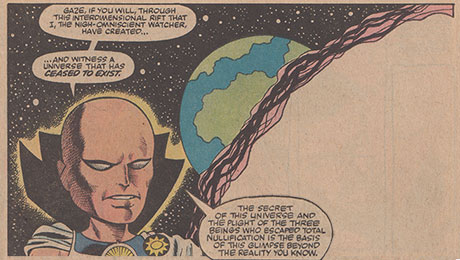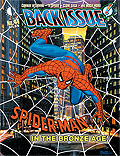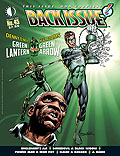NOTE: Today we begin a series of comics reviews that ran in the early days of the Bronze Age Babies. This was our first review (and second post overall), originally published in early July 2009. There were no comments on the post at that time.
Doug: I have a love for comics, specifically men in spandex (insert whatever joke you want here!!). Super-heroes, you know.
Anyway, I occasionally (although not often) get out of the box and read other genres of comics. Of particular note are comics that deal with another passion of mine, and that is study of the Holocaust.
 In my spare time, I am an educator with the United States Holocaust Memorial Museum, and I travel the country (and beyond at times) teaching teachers how to deliver this subject matter to secondary-aged students.
In my spare time, I am an educator with the United States Holocaust Memorial Museum, and I travel the country (and beyond at times) teaching teachers how to deliver this subject matter to secondary-aged students.I use Art Spiegelman's Maus with my own freshmen-level classes, and I've cited that graphic novel as well as Will Eisner's The Plot (an extensive look at the writing and desemination of The Protocols of the Learned Elders of Zion) in my senior-level Social Injustice class. I just finished reading Magneto: Testament, and I want to recommend it to you. The edition I read is hardcover, runs $25 retail, and reprints the five issues of the mini-series that was published in 2008. It also includes historical endnotes and a teacher's guide. While I didn't wholeheartedly agree with all of the lesson suggestions, it would still be a welcome resource for many educators.
If for some reason you aren't up on your X-Men lore, or if you haven't seen any of the three X-films, Magneto is the main bad guy in the mythos. He is a tragic hero, bent on making the world safe for those with mutant powers. He is quite militant, and is opposed by Charles Xavier and his X-Men; think Malcolm X's means vs. Dr. Martin Luther King's means and you get the basic story.
 Make no mistake -- just above I stated that he is a "tragic hero". That's somewhat of a new characterization, as throughout the Silver and Bronze Ages Magneto was one of the premier do-badders in the Marvel Universe. He left a body count, to be certain. But, around 30 years ago, Chris Claremont (and subsequent writers) decided that a way to explain Magneto's militancy in the mutant vs. non-mutant conflict was to set his origins in the Holocaust. Magneto: Testament is the definitive origin/backstory of the character.
Make no mistake -- just above I stated that he is a "tragic hero". That's somewhat of a new characterization, as throughout the Silver and Bronze Ages Magneto was one of the premier do-badders in the Marvel Universe. He left a body count, to be certain. But, around 30 years ago, Chris Claremont (and subsequent writers) decided that a way to explain Magneto's militancy in the mutant vs. non-mutant conflict was to set his origins in the Holocaust. Magneto: Testament is the definitive origin/backstory of the character.This graphic novel could be used in any high school classroom, and is a serious and straightforward look at a German-Jewish family and their lives before and during the Shoah. As a boy in this tale, Magneto exhibits no powers, so this truly is a Holocaust story and not a superhero story in any way. The author and artist (Greg Pak and Carmine Di Giandomenico) were edited by scholars at the Simon Wiesenthal Center; I can say that everything they wrote/drew is accurate to the best of my knowledge -- the Auschwitz I and II scenes are outstanding. I was able to travel to Warsaw and Krakow, Poland last October -- my journey included a tour of Auschwitz I and Auschwitz II-Birkenau.
 The author/editor of this graphic novel use the book's endnotes to offer specific support for many of the scenes in the story. I felt good that what had been presented was rooted in actual events, a danger that historical fiction often faces (and often loses, in my opinion).
The author/editor of this graphic novel use the book's endnotes to offer specific support for many of the scenes in the story. I felt good that what had been presented was rooted in actual events, a danger that historical fiction often faces (and often loses, in my opinion).  Magneto: Testament is a much shorter read than Maus, and probably more accessible to youngsters than The Plot. It is graphically violent in spots, but then I would add that no student of the Holocaust would be surprised at any of the situations depicted. I'd rate the book PG-13 I suppose, but there is more than that implied at times. Of course, with as much violence as generally makes its way in between the pages of the standard 20-page comic these days, perhaps no one will be surprised. I'd offer, however, that "real" violence -- that based on historical fact and in real-world events -- carries a bit more weight, even shock value.
Magneto: Testament is a much shorter read than Maus, and probably more accessible to youngsters than The Plot. It is graphically violent in spots, but then I would add that no student of the Holocaust would be surprised at any of the situations depicted. I'd rate the book PG-13 I suppose, but there is more than that implied at times. Of course, with as much violence as generally makes its way in between the pages of the standard 20-page comic these days, perhaps no one will be surprised. I'd offer, however, that "real" violence -- that based on historical fact and in real-world events -- carries a bit more weight, even shock value.So, if you have time to waste someday at a Barnes and Noble or Borders... or if you will actually part with your hard-earned cash, I'd recommend picking up this collection. I wanted to also give you a head's up that this could prove to be an exciting new resource for secondary teachers.
Note: There is a trade paperback collection available, as well as the hardcover edition.


















































7 comments:
I found a little free time last week to read this since you accidentally let us know you'd be running this post in early January.
A few thoughts: as a story about the Holocaust done in the comics medium, I have to say I thought it was really good. In fact, there were times when I thought it was just as good as, if not better than, Maus. Pak really did his homework, and did a really good job of integrating actual historical events into the story. One thing I also really appreciated was that Pak made it a point to underscore Magda's Roma (Gypsy) heritage, and thus shed light on yet another aspect of the Holocaust, i.e., the attempt to destroy Europe's Roma/Sinti population. And the art by Carmine Di Giandomenico, with coloring by Matt Hollingsworth, also serves the story perfectly: it really conveys the overall bleakness of the period.
That said, I now have to switch into comics geek mode and look at how this fits into the Marvel Universe and Marvel continuity, since it is the story of Magneto's youth – and conclude that it really doesn't (fit, I mean). Because it's really hard to square the boy/young man portrayed in this story with the guy who would later be the ruthless X-men villain, who often seemed to look upon the entire non-mutant human race with almost genocidal contempt – not unlike the way the Nazis and their allied puppet states/client regimes viewed Jews and other 'inferior' peoples. In that sense, i.e., Magneto as an arch-villain, it seems like his experiences in the Holocaust should have led to some kind of psychotic break that would explain his later sociopathic belligerence. Instead, the main character here manages to survive the Holocaust and retain his humanity. So really, I think the best way to read this is to pretty much ignore the Magneto part of the title and simply read it as a stand-alone story.
By the way, I don't know if your HC edition included it, but the borrowed floppies I read included a b&w story at the end, drawn by Neal Adams and inked by Joe Kubert, that recounted the true story of illustrator/cartoonist Dina Babbitt. I found this almost more moving that the main story, simply because as far as the Holocaust (or really, any similar historical tragedy) goes, the actual experiences of individuals who suffered through it convey the horror so much better than fictionalized accounts, no matter how well done.
Nevertheless, I agree with Doug and recommend this quite highly.
I haven't read this, but after reading your review, I want to.
Doug, your efforts to teach young people about this terrible period of history are commendable. These stories need to be remembered, with the hope that they never happen again.
And to answer the question raised by the headline, I don't think it's a travesty to depict the Holocaust or other historical tragedy in a comic book - even a super-hero comic - as long as it is done respectfully and accurately. I don't see a major difference in a comic book story like this one and a film such as "Schindler's List," for example.
Thanks for the comments, guys.
Edo, the material on Dina Babbitt is indeed included in the Marvel Premiere Hardcover edition I own, and I'd assume it's in the tpb as well. Here is a link to the short story created by Neal Adams, Joe Kubert, et al. as it appears on YouTube, for those who'd like to see what we're talking about:
http://www.youtube.com/watch?v=p8Q-7_jLMs4
I did some curriculum work for a company called Menemsha Films a few years ago. One of the pictures for which I co-developed a study guide was As Seen Through These Eyes, which is a film about artists in the Holocaust and their reactions to what they went through. For those of you interested in the creative side of life, I'd highly recommend it. Near the end of the film there is a section on Dina Babbitt and her experiences with Dr. Josef Mengele; her struggle to get her artwork back is not dealt with much, which is a pity -- her struggles against the museum at Auschwitz ring true toward the struggles of Jack Kirby et al. to have their original art returned from companies like Marvel Comics; certainly Neal Adams, Joe Kubert, and others felt the same connection to Ms. Babbitt.
Information about the film is at the link below, and the materials I created are accessible from the link on the left side of the page labelled "Downloads":
http://www.menemshafilms.com/as-seen-through-these-eyes.html
If you're further interested in such things, I also did work on the films The Rape of Europa and Belzec.
The GN at hand today echoes Steven Spielberg's Schindler's List from the standpoint that it begins in full color and then devolves to a gray-ish wash throughout the remainder of the story.
In regard to the issue of historical fiction, and specifically in regard to historical fiction of the Holocaust -- Edo and Bruce both touch on the historically accurate nature of this GN. I take umbrage with literature such as The Boy in the Striped Pajamas and the film of the same name because it does not accurately depict the events of the Shoah, and furthermore does not even serve to complicate the thinking of the reader/viewer in regard to the complexity of the reality that was the Holocaust. No, any entry into Holocaust literature which leaves the receiver feeling sorry for the perpetrators walks outside the line of decency and memory. I really try to stay away from historical fiction in my classroom, and when I do I make sure that I point out the real/not real.
Using Schindler's List, for example, I spend a class period after the viewing going over the film and contrasting it with David Crowe's fine biography of Oskar Schindler. I want to be certain that my students understand where lies the line between history and Hollywood, history and art.
Doug
This looks good. I like how the art looks appropriate for the story.
Although I knew that Claremont had given Magneto a background as a Holocaust survivor of presumably Jewish and Roma ancestry (a double whammy as Hitler & his gang wanted to wipe out both!) but I hadn't heard of this before. I'll definitely have to check it out.
As to how it all fits in with the Marvel Universe as we once knew it, particularly of the Silver & Bronze ages, Edo's advice seems apt. Of course, based on what little I've read of or about the current Marvel universe, most of the Silver Age characters have changed so much that they might as well be different characters despite having the same names, alter egos, and powers, and in most cases the same basic costumes. But that shouldn't be surprising when many of them have been around nearly or more than 50 years and their tales chronicled by dozens of writers.
Anonymous --
Since you made two drive-by comments this afternoon, I'm sure you won't be back by. However, I'd love to hear more of your opinion on this post -- please don't just make a statement without supporting it (on any post). That does nothing for the sense of community that exists on this blog.
Thank you,
Doug
Post a Comment